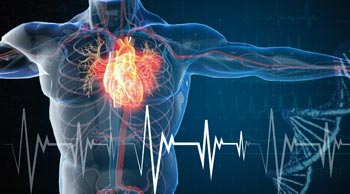Oneida Health
What is Electrical Cardioversion
 Electrical Cardioversion is a procedure in which an electric current is used to reset the heart’s rhythm back to its regular pattern if it is abnormal (arrhythmia). The low-voltage electric current enters the body through patches applied to the chest wall. It’s also possible to do cardioversion with medications. For most people, cardioversion quickly restores a normal heart rhythm.
Electrical Cardioversion is a procedure in which an electric current is used to reset the heart’s rhythm back to its regular pattern if it is abnormal (arrhythmia). The low-voltage electric current enters the body through patches applied to the chest wall. It’s also possible to do cardioversion with medications. For most people, cardioversion quickly restores a normal heart rhythm.
Why the Test is Performed
Cardioversion can correct a heartbeat that’s too fast or irregular. Cardioversion is usually done to treat people who have atrial fibrillation or atrial flutter. These conditions occur when the electrical signals that make your heart beat at a regular rate don’t travel normally through your heart’s upper chambers.
Cardioversion is done by delivering electric shocks to your heart through electrodes attached to your chest. This procedure is done under sedation. Your doctor can instantly see if the procedure has restored a normal heartbeat.
How to Prepare for the Test
This procedure is often scheduled, but can be delivered in an emergency situation if needed. Before the procedure:
- Don’t eat or drink anything for about eight hours prior.
- Talk to your doctor about the medications you are taking and if any of them should be stopped prior to your procedure.
- If your doctor advises you to take your medications, sip just enough water to swallow your pills.
What to Expect During the Test
- Your doctor may want to perform a transesophageal echocardiogram to check for blood clots in your heart prior to your procedure. This is because blood clots may break free when cardioversion is done, creating a life-threatening situation. Your doctor will decide whether you need a transesophageal echocardiogram before cardioversion.
- If blood clots are found, your cardioversion procedure will be delayed for up to four weeks and you will be prescribed blood thinning medication to reduce your risk of clots.
- You’ll be sedated prior to the procedure so that you won’t feel any pain from the electric shocks.
- A nurse or technician places several large electrodes on your chest. The electrodes connect to a cardioversion machine (defibrillator) using wires. The machine records your heart rhythm and delivers shocks to your heart to restore a normal heart rhythm. This machine can also correct your heart’s rhythm if it beats too slowly after cardioversion.
- Once you are sedated, electric cardioversion usually takes only a few minutes to complete. The procedure is done on an outpatient basis, so no need for an overnight stay in the hospital. You will be monitored in the recovery room after the procedure is complete. You will need someone to drive you home, and your ability to make decisions may be affected for several hours after your procedure.
- Even if no clots were found, you’ll take blood-thinning medication after your procedure to prevent new clots from forming.
- For most people, cardioversion can quickly restore a regular heartbeat. It’s possible you’ll need additional procedures to keep a normal heart rhythm.
- Your doctor may suggest lifestyle changes to improve your heart health and prevent or treat conditions that can cause arrhythmias, such as high blood pressure.
- Avoid or limit caffeine and alcohol
- Eat heart-healthy foods
- Increase your physical activity
- Maintain a healthy weight
- Quit smoking
- Try to limit or manage stress and anger
- Use less salt, which can help lower blood pressure
Potential Risks of the Test
Major risks of cardioversion include dislodged blood clots. Some people who have irregular heartbeats have blood clots in their hearts. Electric cardioversion can cause these blood clots to move to other parts of your body.